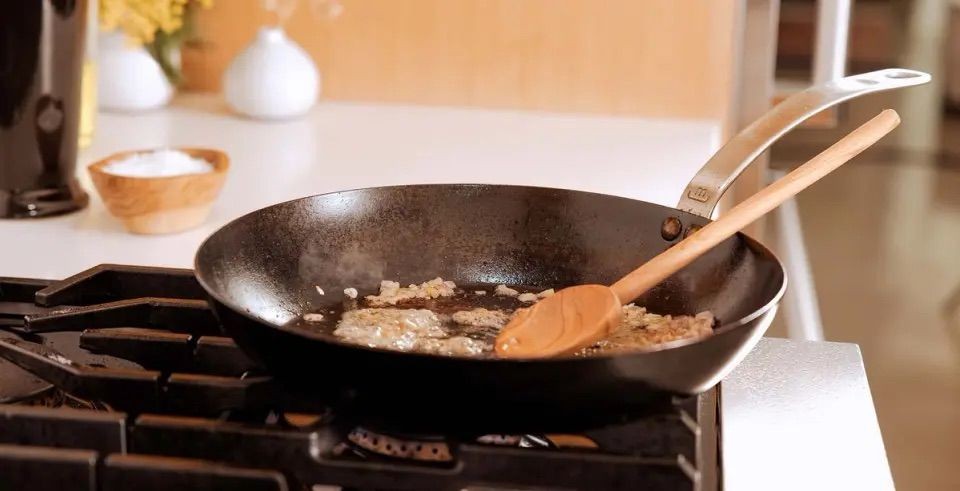Carbon steel cookware is prized for its exceptional searing capabilities and even heat distribution, rivaling cast iron. However, cleaning it requires a more delicate approach to preserve its seasoned surface. This guide provides a comprehensive, hands-on approach to cleaning your carbon steel pan, helping you avoid common mistakes and maintain its optimal performance.
Method One: The Initial Wipe Down
Always begin by wiping your pan after it has cooled down. Use a paper towel, kitchen towel, or microfiber cloth to remove loose food particles and oil. This crucial step prevents residue from hardening and simplifies the cleaning process. Avoid using water or dish soap at this stage, as they can strip away the seasoning. For light meals without stubborn residue, a simple wipe-down might be sufficient.
If wiping alone doesn’t suffice, proceed to the next method for a deeper clean.
Method Two: The Power of Coarse Salt and Oil
For baked-on residue or stubborn fried bits, leverage the abrasive power of coarse salt and a neutral oil. This method gently scrubs away stuck-on food without harsh chemicals.
- Combine equal parts coarse salt (like sea salt or kosher salt) and a neutral oil (such as grapeseed or canola oil) in your cooled pan. A 1:1 ratio, approximately 2 tablespoons of each, is generally recommended.
- Using a kitchen or paper towel, vigorously scrub the mixture across the inside surface of the pan. The salt acts as a mild abrasive, dislodging burnt food particles and polymerized oil.
- Once you’ve removed as much residue as possible, thoroughly wipe and rinse the pan to eliminate any remaining oil, salt, and food debris. Following the rinse, place the pan on a low-heat burner to ensure it is completely dry. Finally, apply a very thin layer of neutral oil to the surface for protection.
If this method still leaves your pan looking grimy, move on to method three for a more intensive cleaning solution.
Method Three: The Boiling Water Technique
When dealing with heavily burnt-on ingredients or stubborn residue, boiling water can effectively loosen even the most challenging deposits.
- Pour just enough water into the pan to cover the bottom surface and bring it to a boil over medium heat.
- As the water boils, gently scrape the pan’s bottom with a wooden or rubber spatula to dislodge any burnt food. Continue scraping until you’ve removed as much of the residue as possible.
- Discard the water and residue, then wipe the pan clean with a kitchen or paper towel. Return the pan to the burner.
- Allow the pan to sit on the burner over medium-low heat until it is thoroughly dry. This step is crucial to prevent rust formation.
- Once the pan is completely dry, apply a thin layer of neutral oil to its surface using a clean kitchen or paper towel, and place it back on the burner for a minute. This helps maintain the pan’s seasoning and prevents it from drying out.
Method Four: The Last Resort – Steel Wool
Steel wool is a highly abrasive tool and should be used only as a last resort. Reserve this method for situations where all other options have failed or when your pan requires significant restoration. Be aware that using steel wool will strip the pan down to its base metal and necessitate re-seasoning.
Gently scrub the affected areas of the pan with steel wool until you reach the raw, silver metal, then rinse thoroughly. Follow the drying instructions in method three before beginning the seasoning process.
Additional Tips for Carbon Steel Cookware Care
Here are some additional points to consider when cooking with carbon steel:
- Carbon steel excels at reaching and maintaining high temperatures, but excessive heat on the stovetop is rarely necessary. Medium heat is typically sufficient for achieving perfect sears and flavorful results.
- Always allow your pan to preheat before adding cooking oil or butter, and then allow the oil or butter to preheat before adding ingredients.
- Let ingredients temper (reach room temperature or close to it) before adding them to the pan. Cold ingredients can stick and contribute to stubborn residue.
Get Cooking with Confidence
Mastering the cleaning techniques outlined above allows you to enjoy the full benefits of carbon steel cookware – durability, exceptional searing power, and even heat distribution. With proper care and maintenance, your carbon steel pan will provide years of reliable performance in the kitchen. Now, go forth and create culinary masterpieces!

